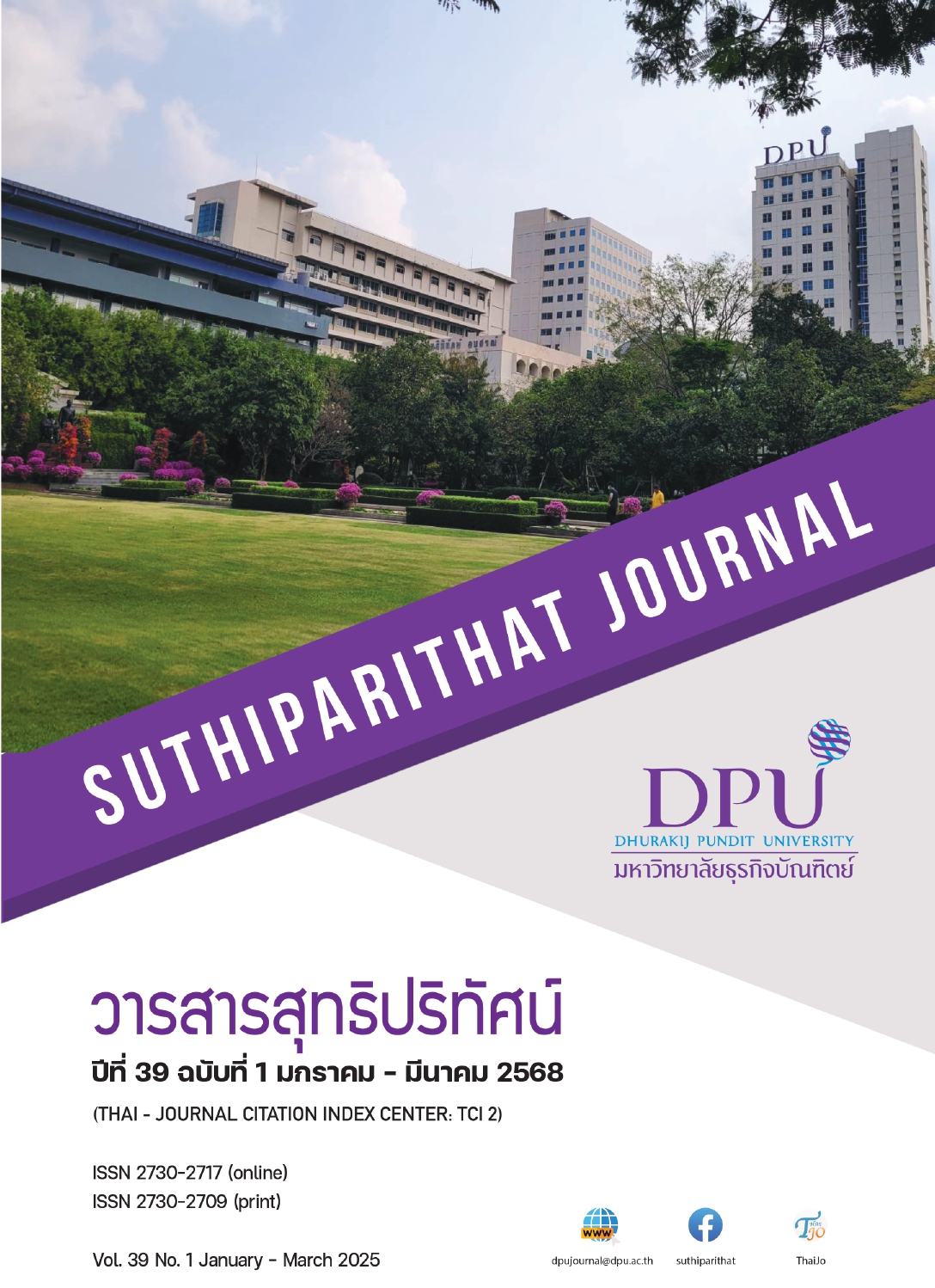คุณภาพบริการอี-คอมเมิร์ซ ความไว้วางใจอิเล็กทรอนิกส์ การใช้ชีวิตที่ยั่งยืน การรับรู้คุณค่าสีเขียว และความภักดีทางอิเล็กทรอนิกส์ของลูกค้า ที่มีต่อผลิตภัณฑ์แฟชั่นที่เป็นมิตรต่อสิ่งแวดล้อมทางอี-คอมเมิร์ซในประเทศไทย
คำสำคัญ:
คุณภาพบริการอี-คอมเมิร์ซ, ความไว้วางใจอิเล็กทรอนิกส์, การใช้ชีวิตที่ยั่งยืน, การรับรู้คุณค่าสีเขียว, ความภักดีทางอิเล็กทรอนิกส์, ผลิตภัณฑ์แฟชั่นที่เป็นมิตรต่อสิ่งแวดล้อมบทคัดย่อ
การวิจัยนี้มีวัตถุประสงค์ 1. เพื่อพัฒนาและตรวจสอบความสอดคล้องของรูปแบบสมการโครงสร้างของปัจจัยที่มีอิทธิพลต่อความภักดีทางอิเล็กทรอนิกส์ของลูกค้าที่มีต่อผลิตภัณฑ์แฟชั่นที่เป็นมิตรต่อสิ่งแวดล้อมทางอี-คอมเมิร์ซในประเทศไทย และ 2. เพื่อศึกษาอิทธิพลทางตรง อิทธิพลทางอ้อม และอิทธิพลโดยรวมต่อความภักดีทางอิเล็กทรอนิกส์ของลูกค้าที่มีต่อผลิตภัณฑ์แฟชั่นที่เป็นมิตรต่อสิ่งแวดล้อมทางอี-คอมเมิร์ซในประเทศไทย เป็นวิจัยเชิงปริมาณที่ใช้แบบสอบถามเป็นเครื่องมือในการเก็บข้อมูลจากกลุ่มลูกค้าที่มีอายุ 18 ปีขึ้นไป ทั้งเพศชายและหญิงในประเทศไทยที่ซื้อหรือใช้ผลิตภัณฑ์แฟชั่นที่เป็นมิตรต่อสิ่งแวดล้อม ประเภท Mass Market Fashion Brands ที่วางจำหน่ายผ่านช่องทางอี-คอมเมิร์ซในประเทศไทย จำนวน 400 ราย และใช้วิธีการการสุ่มตัวอย่างแบบหลายขั้นตอน วิเคราะห์ข้อมูลด้วยสถิติเชิงพรรณาและตัวแบบสมการเชิงโครงสร้าง ผลการวิจัยพบว่า แบบจำลองสมการเชิงโครงสร้างของปัจจัยที่มีอิทธิพลต่อความภักดีทางอิเล็กทรอนิกส์ของลูกค้าที่มีต่อผลิตภัณฑ์แฟชั่นที่เป็นมิตรต่อสิ่งแวดล้อมทางอี-คอมเมิร์ซในประเทศไทยมีความสอดคล้องกลมกลืนกับข้อมูลเชิงประจักษ์ ผลการทดสอบสมมติฐานพบว่า 1. คุณภาพบริการอี-คอมเมิร์ซมีอิทธิพลทางตรงต่อความไว้วางใจอิเล็กทรอนิกส์ของลูกค้าที่มีต่อผลิตภัณฑ์แฟชั่นที่เป็นมิตรต่อสิ่งแวดล้อมทางอี-คอมเมิร์ซในประเทศไทย 2. คุณภาพบริการอี-คอมเมิร์ซ และการใช้ชีวิตที่ยั่งยืนมีอิทธิพลทางตรงต่อการรับรู้คุณค่าสีเขียวของลูกค้าที่มีต่อผลิตภัณฑ์แฟชั่นที่เป็นมิตรต่อสิ่งแวดล้อมทางอี-คอมเมิร์ซในประเทศไทย 3. ความไว้วางใจอิเล็กทรอนิกส์ การรับรู้คุณค่าสีเขียว และการใช้ชีวิตที่ยั่งยืนมีอิทธิพลทางตรงต่อความภักดีทางอิเล็กทรอนิกส์ของลูกค้าที่มีต่อผลิตภัณฑ์แฟชั่นที่เป็นมิตรต่อสิ่งแวดล้อมทางอี-คอมเมิร์ซในประเทศไทย 4. คุณภาพบริการอี-คอมเมิร์ซมีอิทธิพลทางอ้อมต่อความภักดีทางอิเล็กทรอนิกส์ของลูกค้าที่มีต่อผลิตภัณฑ์แฟชั่นที่เป็นมิตรต่อสิ่งแวดล้อมทางอี-คอมเมิร์ซในประเทศไทย ผ่านความไว้วางใจอิเล็กทรอนิกส์ และผ่านการรับรู้คุณค่าสีเขียว และ 5. การใช้ชีวิตที่ยั่งยืนมีอิทธิพลทางอ้อมต่อความภักดีทางอิเล็กทรอนิกส์ของลูกค้าที่มีต่อผลิตภัณฑ์แฟชั่นที่เป็นมิตรต่อสิ่งแวดล้อมทางอี-คอมเมิร์ซในประเทศไทย ผ่านการรับรู้คุณค่าสีเขียว ที่ระดับนัยสำคัญทางสถิติ 0.001
เอกสารอ้างอิง
กมลวรรณ พัชรพรพิพัฒน์ สารสุข และกมลศิริ วงศ์หมึก. (2567). การออกแบบลวดลายพิมพ์บล็อกไม้บนผ้าย้อมเปลือก โกงกางจากอัตลักษณ์ชุมชนคลองปากปิด อำเภอบางสะพาน จังหวัดประจวบคีรีขันธ์. วารสารศิลปกรรมศาสตร์ มหาวิทยาลัยขอนแก่น, 16(1), 135-153. https://so02.tci-thaijo.org/index.php/fakku/article/view/264116
กรมส่งเสริมการค้าระหว่างประเทศ. (2562). สินค้าแฟชั่นรักษ์โลกในสหรัฐอเมริกา (Sustainable fashion). https://www.ditp.go.th/contents_attach/568721/568721.pdf
กัลยา วานิชย์บัญชา. (2551). การวิเคราะห์สถิติขั้นสูงด้วย SPSS for windows (พิมพ์ครั้งที่ 5). จุฬาลงกรณ์มหาวิทยาลัย.
ตลาด “อี-คอมเมิร์ซ” ไทยโตต่อเนื่อง พบผู้ใช้งานกว่า 41.5 ล้านคน. (2566, 25 มิถุนายน). ฐานเศรษฐกิจ. https://www.thansettakij.com/finance/financial-banking/569081
พิมพ์เขียว Thailand 4.0. (2560, 15 พฤศจิกายน). สำนักงานพัฒนาวิทยาศาสตร์และเทคโนโลยีแห่งชาติ. https://www.nstda.or.th/home/knowledge_post/blueprint-thailand-4/
ภูชิสส์ คุณพิพัฒน์กุล. (2565, 26 เมษายน). When mass fashion is more sustainability’ เมื่อแบรนด์แมสหันมาใส่ใจเรื่องความยั่งยืนไม่แพ้แบรนด์ไฮแฟชั่น. LIPS. https://www.lips-mag.com/when-mass-fashion-is-more-sustainability/
วรรณี แกมเกตุ. (2551). วิธีวิทยาการวิจัยทางสังคมศาสตร์ (พิมพ์ครั้งที่ 2). จุฬาลงกรณ์มหาวิทยาลัย.
e-Commerce ไทยยุคหลัง COVID-19. (2564, 10 มิถุนายน). สำนักงานพัฒนาธุรกรรมทางอิเล็กทรอนิกส์. https://www.etda.or.th/th/Useful-Resource/Knowledge-Sharing/Perspective-on-Future-of-e-Commerce.aspx
Techsauce Team. (2564, 19 สิงหาคม). Fast fashion กับ sustainability จะไปด้วยกันได้อย่างไร เมื่อการตลาด
มีบทบาทสำคัญต่อการเลือกบริโภค. Techsauce Knowledge Platform. https://techsauce.co/saucy-thoughts/what-is-fast-fashion-and-how-dangerous-it-is
Akenji, L., & Chen, H. (2016). A framework for shaping sustainable lifestyles: Determinants and strategies. United Nations Environment Program (UNEP).
Amoako, G. K., Dzogbenuku, R. K., & Abubakari, A. (2020). Do green knowledge and attitude influence the youth's green purchasing? Theory of planned behavior. International Journal of Productivity and Performance Management, 69(8), 1609-1626. https://doi.org/10.1108/IJPPM-12-2019-0595
Bentler, P. M., & Chou, C. P. (1987). Practical issues in structural modeling. Sociological Methods & Research, 16(1), 78-117. https://doi.org/10.1177/0049124187016001004
Bowen, G., & Bowen, R. (2015). Offline and online brand trust models: Their relevance to social media. Journal of Business and Economics, 6(1), 102-112. https://doi.org/10.15341/jbe(2155-7950)/01.06.2015/010
Channa, N. A., Tariq, B., Samo, A. H., Ghumro, N. H., & Qureshi, N. A. (2022). Predicting consumers' intentions to purchase eco-friendly athletic wear in a moderated model of individual green values and gender. International Journal of Sports Marketing and Sponsorship, 23(2), 410-436. https://doi.org/10.1108/IJSMS-12-2020-0215
Che-Hui, L., Wen, M. J., & Chung-Cheng, W. (2011). Investigating the relationships among E-service quality, perceived value, satisfaction, and behavioral intentions in Taiwanese online shopping. Asia Pacific Management Review, 16(3), 221-223.
Chen, Y. S., & Chang, C. H. (2012). Enhance green purchase intentions: The roles of green perceived value, green perceived risk, and green trust. Management Decision, 50(3), 502-520. https://doi.org/10.1108/00251741211216250
Cochran, W. G. (1977). Sampling techniques (3rd ed.). John Wiley & Sons.
Dagher, G. K., & Itani, O. (2014). Factors influencing green purchasing behaviour: Empirical evidence from the Lebanese consumers. Journal of Consumer Behaviour, 13(3), 188-195. https://doi.org/10.1002/cb.1482
Demir, A., Maroof, L., Sabbah Khan, N. U., & Ali, B. J. (2021). The role of E-service quality in shaping online meeting platforms: A case study from higher education sector. Journal of Applied Research in Higher Education, 13(5), 1436-1463. https://doi.org/10.1108/JARHE-08-2020-0253
Demir, M., Rjoub, H., & Yesiltas, M. (2021). Environmental awareness and guests’ intention to visit green hotels: The mediation role of consumption values. Plos One, 16(5), Article e0248815. https://doi.org/10.1371/journal.pone.0248815
Dimitrova, A., Vaishar, A., & Šťastná, M. (2021). Preparedness of young people for a sustainable lifestyle: Awareness and willingness. Sustainability, 13(13), Article 7204. https://doi.org/10.3390/su13137204
Fang, J., Wen, C., George, B., & Prybutok, V. R. (2016). Consumer heterogeneity, perceived value, and repurchase decision-making in online shopping: The role of gender, age, and shopping motives. Journal of Electronic Commerce Research, 17(2), 116-131. http://www.jecr.org/sites/default/files/17_2Paper2.pdf
Farivar, S., Turel, O., & Yuan, Y. (2017). A trust-risk perspective on social commerce use: An examination of the biasing role of habit. Internet Research, 27(3), 586-607. https://doi.org/10.1108/IntR-06-2016-0175
First Insight. (2021). The state of consumer spending: Gen Z Influencing all generations to make sustainability-first purchase decisions. https://f.hubspotusercontent10.net/hubfs/160569/The%20State%20of%20Consumer%20Spending%20-%20Gen%20Z%20Influencing%20All%20Generations.pdf
Fornell, C., & Larcker, D. F. (1981). Structural equation models with unobservable variables and measurement error: Algebra and statistics. Journal of Marketing Research, 18(3), 382-388. https://doi.org/10.1177/002224378101800313
Giao, H., Vuong, B., & Quan, T. (2020). The influence of website quality on consumer’s e-loyalty through the mediating role of e-trust and e-satisfaction: An evidence from online shopping in Vietnam. Uncertain Supply Chain Management, 8(2), 351-370. http://dx.doi.org/10.5267/j.uscm.2019.11.004
Hair, J. F., Black, W. C., Babin, B. J., Anderson, R. E., & Tatham, R. (2010). Multivariant data analysis. Pearson International Edition.
Hu, L. T., & Bentler, P. M. (1998). Fit indices in covariance structure modeling: Sensitivity to underparameterized model misspecification. Psychological Methods, 3(4), 424-453. https://psycnet.apa.org/doi/10.1037/1082-989X.3.4.424
Jalu, G., Dasalegn, G., Japee, G., Tangl, A., & Boros, A. (2023). Investigating the effect of green brand innovation and green perceived value on green brand loyalty: Examining the moderating role of green knowledge. Sustainability, 16(1), 341. https://doi.org/10.3390/su16010341
Jeon, M. M., & Jeong, M. (2017). Customers’ perceived website service quality and its effects on e-loyalty. International Journal of Contemporary Hospitality Management, 29(1), 438-457. https://doi.org/10.1108/IJCHM-02-2015-0054
Khandual, A., Pradhan, S. (2019). Fashion brands and consumers approach towards sustainable fashion. In S. Muthu (Ed.), Fast fashion, fashion brands and sustainable consumption textile science and clothing technology (pp. 37-54). Springer. https://doi.org/10.1007/978-981-13-1268-7_3
Kim, J. (2021). Platform quality factors influencing content providers’ loyalty. Journal of Retailing and Consumer Services, 60, Article 102510. https://doi.org/10.1016/j.jretconser.2021.102510
Kim, J., Jin, B., & Swinney, J. L. (2009). The role of etail quality, e-satisfaction and e-trust in online loyalty development process. Journal of Retailing and Consumer Services, 16(4), 239-247. https://doi.org/10.1016/j.jretconser.2008.11.019
López-Miguens, M. J., & Vázquez, E. G. (2017). An integral model of e-loyalty from the consumer's perspective. Computers in Human Behavior, 72, 397-411. https://doi.org/10.1016/j.chb.2017.02.003
Lovelock, C. H., & Wirtz, J. (2011). Services marketing: People, technology, strategy (7th ed.). Prentice Hall.
Nunnally, J. C. (1967). Psychometric theory. McGraw-Hill.
Pasaribu, F., Sari, W., Bulan, T., & Astuty, W. (2022). The effect of e-commerce service quality on customer satisfaction, trust and loyalty. International Journal of Data and Network Science, 6(4), 1077-1084. http://dx.doi.org/10.5267/j.ijdns.2022.8.001
Prasetyo, J. H., Prakoso, B. S., Wiharso, G., & Fabrianto, L. (2021). E-commerce: The importance role of customer perceived value in increasing online repurchase intention. Dinasti International Journal of Digital Business Management, 2(6), 955-962. https://doi.org/10.31933/dijdbm.v2i6.954
Prentice, C., & Kadan, M. (2019). The role of airport service quality in airport and destination choice. Journal of Retailing and Consumer Services, 47, 40-48. https://doi.org/10.1016/j.jretconser.2018.10.006
Rosmarin, R. (2020, April 22). Sustainability sells: Why consumers and clothing brands alike are turning to sustainability as a guiding light. Business Insider. https://www.businessinsider.com/sustainability-as-a-value-is-changing-how-consumers-shop
Sadeghi, A., Ghujali, T., & Bastam, H. (2019). The effect of organizational reputation on e-loyalty: The roles of e-trust and e-satisfaction. ASEAN Marketing Journal, 10(1), Article 1. https://scholarhub.ui.ac.id/amj/vol10/iss1/1https://doi.org/10.21002/amj.v10i1.10628
Sangroya, D., & Nayak, J. K. (2017). Factors influencing buying behaviour of green energy consumer. Journal of Cleaner Production, 151, 393-405. https://doi.org/10.1016/j.jclepro.2017.03.010
Schumacker, R. E., & Lomax, R. G. (2010). A beginner’s guide to structural equation modeling. Routledge.
Seckler, M., Heinz, S., Forde, S., Tuch, A. N., & Opwis, K. (2015). Trust and distrust on the web: User experiences and website characteristics. Computers in Human Behavior, 45, 39-50. https://doi.org/10.1016/j.chb.2014.11.064
Sharma, A., & Bahl, D. S. (2019). Customer preferences for different service quality dimensions in selected e-commerce websites in India. Journal of Management, 6(3), 77-95. https://doi.org/10.34218/jom.6.3.2019.010
Si, Y. (2021). Research on the balanced relationship between online consumer behavior and e-commerce service quality based on 5G network. Mobile Information Systems, Article 5562996. https://doi.org/10.1155/2021/5562996
Tan, B. C. (2011). The roles of knowledge, threat, and PCE on green purchase behaviour. International Journal of Business and Management, 6(12), 14-27. http://dx.doi.org/10.5539/ijbm.v6n12p14
Tzavlopoulos, Ι., Gotzamani, K., Andronikidis, A., & Vassiliadis, C. (2019). Determining the impact of e-commerce quality on customers’ perceived risk, satisfaction, value and loyalty. International Journal of Quality and Service Sciences, 11(4), 576-587. https://doi.org/10.1108/IJQSS-03-2019- 0047
Wani, A. Z., Bhatnagar, A., & Mir, M. A. (2023). The impact of e-service quality on e-loyalty and revisit intention through the mediating role of e-satisfaction and E-trust. African Journal of Hospitality, Tourism and Leisure, 12(2), 555-573. https://doi.org/10.46222/ajhtl.19770720.385
Woo, E., & Kim, Y. G. (2019). Consumer attitudes and buying behavior for green food products: From the aspect of green perceived value (GPV). British Food Journal, 121(2), 320-332. https://doi.org/10.1108/BFJ-01-2018-0027
ดาวน์โหลด
เผยแพร่แล้ว
รูปแบบการอ้างอิง
ฉบับ
ประเภทบทความ
สัญญาอนุญาต
ลิขสิทธิ์ (c) 2024 มหาวิทยาลัยธุรกิจบัณฑิตย์

อนุญาตภายใต้เงื่อนไข Creative Commons Attribution-NonCommercial-NoDerivatives 4.0 International License.
เนื้อหาและข้อมูลในบทความที่ลงตีพิมพ์ในวารสารสุทธิปริทัศน์ ถือเป็นข้อคิดเห็นและความรับผิดชอบของผู้เขียนบทความโดยตรงซึ่งกองบรรณาธิการวารสาร ไม่จำเป็นต้องเห็นด้วย หรือร่วมรับผิดชอบใด ๆ
บทความ ข้อมูล เนื้อหา รูปภาพ ฯลฯ ที่ได้รับการตีพิมพ์ในวารสารสุทธิปริทัศน์ ถือเป็นลิขสิทธิ์ของวารสารสุทธิปริทัศน์หากบุคคลหรือหน่วยงานใดต้องการนำทั้งหมดหรือส่วนหนึ่งส่วนใดไปเผยแพร่ต่อหรือเพื่อกระทำการใด ๆ จะต้องได้รับอนุญาตเป็นลายลักษณ์อักษรจากวารสารสุทธิปริทัศน์ก่อนเท่านั้น







